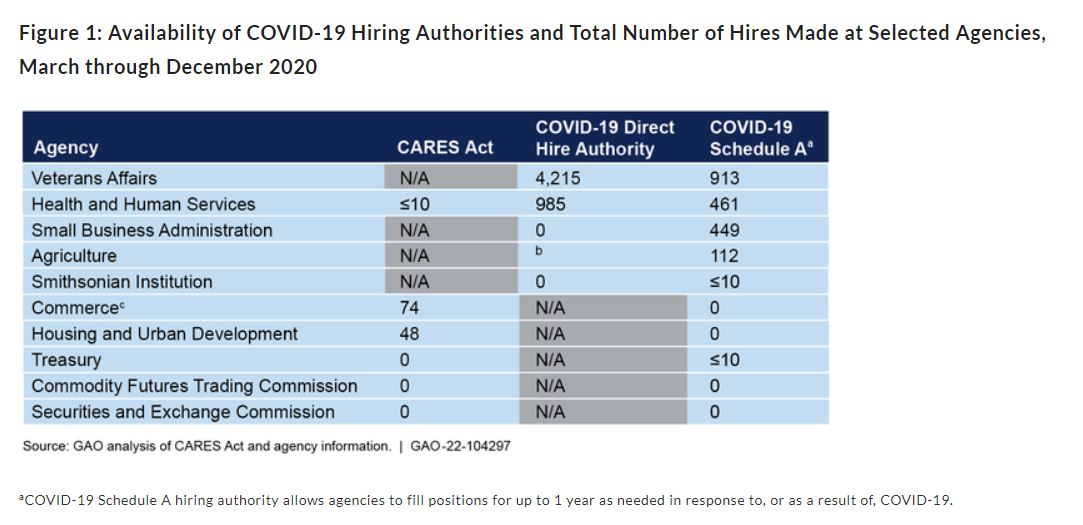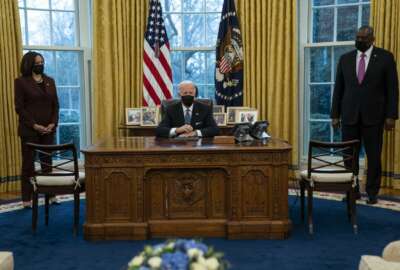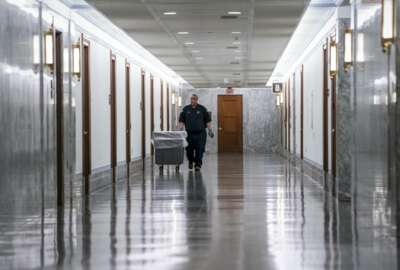Agency safety and reentry plans varied considerably during initial days of the pandemic, GAO finds
Agencies initially moved through reentry phases at different rates, and the phases themselves had different characteristics and criteria, the Government Account...
Agency plans to keep their workforces safe and staff up for the pandemic have shifted and changed significantly over the last 18 months, the Government Accountability Office said this week in a series of reports on the government’s response to COVID-19.
When it came to making plans for their employees to safely return to the office, GAO found a real mixed bag among agencies, though those plans did eventually improve with more guidance and a new oversight structure from the incoming Biden administration.
Initial reentry plans were inconsistent across government, GAO said, and most agencies didn’t address all aspects of the recommended safety guidance that the Office of Personnel Management and Office of Management and Budget released last spring.
And while agencies communicated with each other during President’s Management Council meetings and other forums on workplace safety challenges, there was little overarching oversight from the Trump administration over agency plans, GAO said.
All departments developed phased reentry plans. But agencies moved through those phases at different rates, and the phases themselves had different characteristics and criteria, GAO said.
On one hand, variations make sense because each agency has its own mission and may be subject to different state and local guidelines depending on its location. But GAO noted inconsistencies among agencies within similar geographical areas.
“Some agencies relied mainly on state and local guidance to inform reentry decisions, while others conducted their own internal analysis of state and local data for decision-making. However, this inconsistency means that government employees located in the same area, but working for different agencies, might have been subject to different safety protocols,” GAO reported.
In the National Capital Region, for example, some agencies never lifted their maximum telework posture, while others made it as far as phase two in their reentry plans, GAO said.
The phases themselves meant different things to different agencies, and capacity limits — for those that set them — varied widely.
Agencies in the first phase of their reentry plans set capacity limits that ranged from 10-to-40%, while occupancy caps for the second phase varied from 25-to-80%, GAO said.
Put another way, federal employees at one agency in phase two of its reentry plan could have been working in an office that was 80% full, while an employee at another agency with phase two reopening could have been working with a quarter of his or her coworkers.
In addition, agencies made decisions about their reentry plans in different ways, GAO said. Some agencies delegated decision making to their components, while others had headquarters leadership make decisions about when to open and close their facilities around the country.
None of the agencies’ 2020 reentry plans covered all aspects from the Trump administration guidance. Most agencies, for example, didn’t detail how they would protect their employees if they raised concerns about the safety of their workplace, GAO said.
Guidance on mask wearing also varied at that time. GAO said several agencies didn’t require masks in all of their locations, while some organizations didn’t require them at all. Some agencies left mask wearing up to the discretion of individual leaders and supervisors at each facility.
Agencies eventually developed more comprehensive and consistent safety and reentry plans earlier this year, when the Biden administration created the Safer Federal Workforce Task Force through an executive order, GAO said.
The task force, run by the White House COVID-19 coordinator, Office of Personnel Management and General Services Administration, issued new model safety principles, set a 25% occupancy limit on most federal buildings and called on agencies to create new pandemic coordination teams.
“Most agencies reported either sustained or improved coordination after the establishment of the task force,” GAO wrote. “In particular, agencies highlighted the task force members’ engagement in workplace safety implementation and responsiveness to questions. Two agencies reported that the task force assigned them a health expert, with whom they worked to address specific safety matters and to inform workplace safety plan development.”
Agencies consistently required masks and social distancing in their new COVID safety plans, and the new task force reviewed those plans. Staff at the Office of Management and Budget told GAO they weren’t seeing as many inconsistencies with the new COVID-safety plans.
But they weren’t perfect, GAO said.
Some agencies didn’t address how they would help their supervisors handle suspected or positive COVID cases in their workplaces, and some organizations struggled to identify points of contact for questions about employees’ medical information, GAO said.
Agencies hired a few thousand new employees with special authorities
When it came to using special hiring authorities to quickly bring on more talent for the pandemic, GAO also found mixed results.
Some agencies initially struggled to use new hiring authorities that Congress and OPM created or shortened, GAO said.
Congress gave direct hire authority to five agencies for the pandemic, which included the Departments of Health and Human Services, Housing and Urban Development, Commerce and Treasury, as well as the Securities and Exchange Commission and Commodity Future Trading Commission. These hiring authorities were part of the Coronavirus Aid, Relief and Economic Security (CARES) Act.
OPM also expedited the process it normally used to review direct hire authority requests from agencies. The Agriculture Department, Department of Veterans Affairs, HHS, Small Business Administration and Smithsonian Institution all got direct hire authorities from OPM through this expedited process, which approved them within a seven-day window.
Finally, OPM allowed agencies to use Schedule A hiring authority to recruit new hires to one-year appointments for the pandemic.
All told, agencies used a variety of direct hire authorities to bring on a few thousand new employees during the first year of the pandemic. But not all of the agencies that received these new authorities used them, GAO said.

VA, by far, was the heaviest user of these new hiring authorities in 2020, according to GAO. And while some agencies didn’t use these special authorities to bring on new hires for the pandemic in 2020, several departments said they planned to use those flexibilities this year.
Treasury, for example, is using CARES Act authorities this year to hire new employees.
According to GAO, VA used these flexibilities to hire a large number of food service workers and health aides, while HHS mostly used the authorities for public health analysts and advisers.
Some agencies struggled with the hiring authorities at first, GAO said, because they weren’t accustomed to using these flexibilities in the first place. Other agencies struggled because they didn’t have a clear vision of their hiring needs in the early days of the pandemic.
Over time, agencies began to collaborate with each other and shared advice about using these hiring flexibilities. Other departments formed working groups and created inventories of available authorities, which GAO said helped some agencies better understand the flexibilities they could use to fill certain positions.
Other agencies found success in using the new authorities and existing federal talent acquisition systems to hire a large volume of new employees at the same time.
The Small Business Administration, for example, found that many of its candidates applied to multiple positions or jobs in more than one location at the agency.
SBA eventually developed an external applicant system, which tracked their candidates’ email addresses. That method helped the agency more easily identify duplicate candidates and make job offers, GAO said.
Still, GAO said departments could use more opportunities to learn from each other about these hiring authorities and practices, and it encouraged OPM to gather these lessons so agencies could prepare for future emergencies.
OPM ultimately agreed, and it’s planning to review how agencies used these special hiring authorities during upcoming human capital reviews in 2022, GAO said.
Copyright © 2024 Federal News Network. All rights reserved. This website is not intended for users located within the European Economic Area.
Nicole Ogrysko is a reporter for Federal News Network focusing on the federal workforce and federal pay and benefits.
Follow @nogryskoWFED






